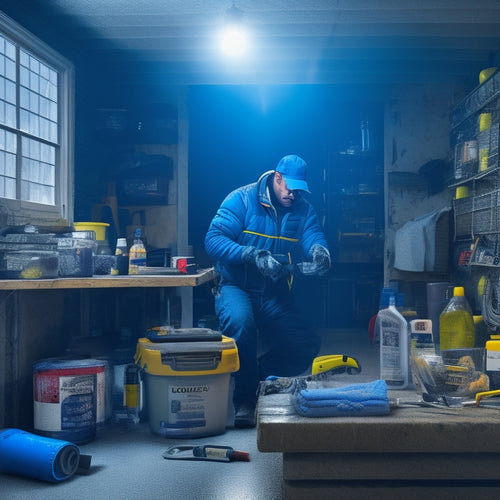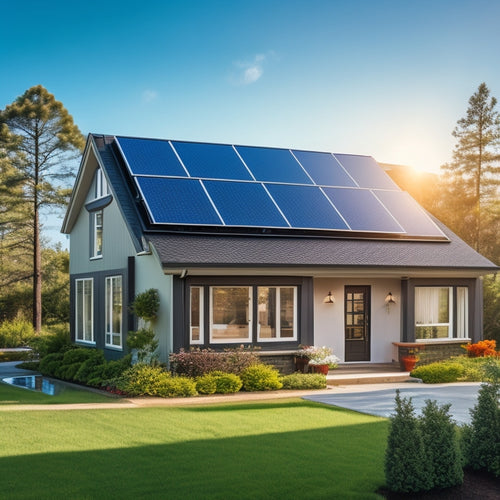
What Are the Key Costs of Installing Solar Panels at Your Home
Share
When installing solar panels at your home, you'll need to evaluate several key cost categories. The initial investment breaks down into equipment and materials, labor, permits, and financing options. Equipment and materials, including solar panels, inverters, and mounting hardware, account for around 20% of total costs. Labor expenses, project management fees, and permitting and inspection fees add to the overall cost. You may also need to budget for roof and structural upgrades, as well as ongoing maintenance expenses like cleaning, monitoring, and potential repairs. Understanding these costs will help you make an informed decision - and there's more to investigate when it comes to getting the most out of your solar panel investment.
Key Takeaways
- The initial investment in solar panels includes equipment, labor, and permits, with financing options available for upfront payment, loans, or leasing.
- Equipment and material costs, around 20% of total installation costs, vary based on solar panel quality, mounting hardware, and inverter prices.
- Labor expenses depend on the installer's hourly rate, number of workers, and project management fees, which impact the overall cost and efficiency.
- Permitting and inspection fees, ranging from $500 to $2,000, ensure compliance with local building codes and regulations.
- Ongoing maintenance expenses, including warranty coverage, cleaning, and system monitoring, are necessary for optimal energy production and system longevity.
Initial Investment Breakdown
Typically, the initial investment for solar panels falls into three main categories: equipment, labor, and permits. You'll need to evaluate these costs when deciding to install solar panels at your home.
Equipment costs cover the solar panels themselves, inverters, and mounting hardware. Labor costs include the installation, wiring, and electrical work required to connect your system to the grid. Permits and inspections are also necessary to guarantee your system meets local building codes and safety standards.
Fortunately, you have various financing options to help offset these costs. You can choose to pay upfront, finance through a loan, or lease a system. Additionally, you may be eligible for tax incentives, such as the Solar Investment Tax Credit (ITC), which allows you to claim a percentage of your total costs as a credit on your taxes.
These incentives can considerably reduce your overall expenditure. By understanding the breakdown of your initial investment, you can make informed decisions about how to approach your solar panel installation project.
Equipment and Material Costs
When calculating equipment and material costs, you'll need to take into account the quality of solar panels, which can vary considerably in price and efficiency.
Mounting hardware costs, including racking and tracking systems, can also add up quickly.
Additionally, the price range for inverters, which convert DC power to AC, will also impact your overall installation costs.
Solar Panel Quality
About 20% of the overall cost of your solar panel installation goes towards the equipment and materials themselves, which is why it's crucial to focus on solar panel quality.
When evaluating solar panels, you'll want to take into account their efficiency, which is measured by the amount of electricity they produce per hour of sunlight. Higher-efficiency panels may cost more, but they'll generate more power per hour, making them a better long-term investment.
You should also look for solar panels with high-quality materials and construction, as these will be more durable and require less maintenance over time.
Additionally, examine the installation warranties offered by different manufacturers. A longer warranty period provides greater peace of mind, as it guarantees that you're protected in case any issues arise with your solar panels.
Mounting Hardware Costs
You'll need to factor in the cost of mounting hardware when calculating the overall expense of your solar panel installation.
Mounting hardware refers to the equipment and materials required to securely fasten your solar panels to your roof. This includes items like brackets, clamps, and tracking systems. The cost of mounting hardware varies depending on the type and quality of the equipment, as well as the complexity of the installation.
Different mounting techniques require different hardware, and some are more expensive than others. For example, a ballasted mounting system, which uses weights to secure the panels, may be more costly than a traditional racked system.
Additionally, installation safety is a critical consideration, and high-quality mounting hardware is vital to guarantee the safety of the installation team and the long-term integrity of the system.
On average, mounting hardware costs can range from $1,500 to $3,000 for a typical residential solar panel installation, depending on the size of the system and the complexity of the installation.
Be sure to factor this expense into your overall budget to get an accurate estimate of the total cost of your solar panel installation.
Inverter Price Range
Jump into calculating the cost of your solar panel installation and you'll quickly realize that inverters are a significant expense. Inverters convert the DC power generated by your solar panels into AC power that's usable in your home. They're an essential component of your solar panel system, and their cost can vary widely.
The price range for inverters depends on the type and quality of the inverter. Here are some factors that affect the cost:
-
Inverter types: String inverters, microinverters, and power optimizers each have their own price points. String inverters are the most common and cost-effective option, while microinverters are more expensive but offer greater flexibility.
-
Inverter power rating: The higher the power rating, the more expensive the inverter. You'll need an inverter that can handle the total power output of your solar panel system.
-
Inverter lifespan: High-quality inverters with a longer lifespan (up to 25 years or more) are more expensive than those with a shorter lifespan. However, they can provide greater long-term value and reliability.
Installation Labor Expenses
When you're installing solar panels, you'll need to contemplate the labor expenses involved.
The per hour labor rate of the installers, the number of professionals needed to complete the job, and the project management fees will all impact your overall cost.
These factors will vary depending on the complexity of your installation and the location of your project.
Per Hour Labor Rate
Skill comes at a price, and the cost of hiring skilled labor is a significant component of the overall installation expense. When you decide to install solar panels, you'll need to take into account the per hour labor rate of the installation team. This rate varies depending on several factors, including the location, experience, and qualifications of the installers.
Wage variations exist across different regions, with urban areas typically commanding higher rates than rural areas.
Regional differences in cost of living, taxes, and other expenses also influence labor rates.
The complexity of your solar panel installation project can also impact the labor rate, as more complex projects may require specialized skills and equipment.
As you research installation companies, be sure to ask about their labor rates and what they include. A higher labor rate doesn't always mean better quality, so be sure to evaluate the overall value proposition.
Number of Installers Needed
Two to three installers are typically required for a standard residential solar panel installation, although this number can vary depending on the size and complexity of your project.
The number of installers needed directly impacts your installation labor expenses. More installers may be required for larger systems or those with unique requirements, such as custom mounting systems or complex electrical configurations.
You should also consider the installer qualifications when evaluating the number of installers needed. More experienced installers may be able to complete the job more efficiently, reducing the overall installation timeline.
On the other hand, less experienced installers may require more time and labor to complete the job, increasing your costs.
When evaluating bids from different installers, pay attention to the number of installers they plan to assign to your project and their qualifications.
A reputable installer will be able to provide you with a clear plan for the installation, including the number of installers and the expected installation timeline.
This will help you make an informed decision and guarantee that your project is completed efficiently and effectively.
Project Management Fees
Project management fees, an essential component of installation labor expenses, encompass the costs associated with overseeing and coordinating your solar panel installation project. These fees cover the proficiency and time required to guarantee your project is completed efficiently and effectively.
As the homeowner, you'll want to work with a project manager who can maneuver the intricacies of your project, from permits to inspections, and guarantee that everything stays on track.
Some key aspects of project management fees include:
- Developing a detailed project timeline to minimize delays and guarantee a smooth installation process
- Coordinating with local authorities to obtain necessary permits and approvals
- Overseeing contractor selection and guaranteeing that all work meets quality and safety standards
Permitting and Inspection Fees
Because local governments regulate solar panel installations to guarantee compliance with building codes and safety standards, you'll need to obtain necessary permits and undergo inspections, incurring associated fees.
These permitting requirements vary by jurisdiction, but typically involve electrical, building, and zoning permits. You'll need to submit plans and specifications for your solar panel system, which will be reviewed by local authorities to verify compliance with applicable codes and regulations.
The inspection processes typically involve multiple site visits to verify that your solar panel system is installed correctly and safely. Inspectors will check the system's electrical connections, mounting, and overall performance to confirm it meets safety standards.
You'll need to pay for these inspections, which can range from $500 to $2,000, depending on the complexity of the installation and the number of inspections required. Your solar panel installer may include these fees in their overall quote, or you may need to pay them separately.
Be sure to factor these costs into your overall budget to avoid unexpected expenses.
Roof and Structural Upgrades
Your solar panel installation may require roof and structural upgrades to guarantee a safe and secure mounting system. This is especially important if your roof is old, damaged, or has a complex design. The upgrades will confirm that your roof can support the weight of the solar panels and withstand various environmental conditions.
Some common upgrades you may need to contemplate include:
-
Re-roofing or re-flashing: If your roof is old or damaged, you may need to replace it entirely or re-flash it to provide a watertight seal around the solar panels.
-
Structural reinforcements: If your roof has a complex design or lacks structural integrity, you may need to add reinforcements such as beams or brackets to support the solar panels.
-
Roof orientation adjustments: If your roof's orientation isn't ideal for solar energy production, you may need to adjust it to maximize energy output. This could involve installing additional roof trusses or modifying the roof's pitch.
These upgrades are vital to confirm that your solar panel system operates safely and efficiently.
Be sure to factor these costs into your overall budget to avoid any surprises down the line.
Ongoing Maintenance Expenses
As you enjoy the benefits of solar energy, it's vital to contemplate the ongoing maintenance expenses that come with owning a solar panel system.
While the initial installation cost is significant, you'll need to budget for regular maintenance to guarantee your system operates at peak levels.
Typically, solar panel manufacturers provide warranty coverage for 25 years or more, covering repairs and replacements for defective parts.
However, this warranty doesn't cover maintenance tasks like cleaning the panels or inspecting the system. You'll need to factor in the cost of periodic cleaning, which can range from $100 to $300 per year, depending on the size of your system.
System monitoring is another fundamental aspect of maintenance.
This involves tracking your system's performance to identify potential issues before they become major problems.
While some monitoring services are free, others may charge a monthly or annual fee.
On average, you can expect to pay around $100 to $300 per year for system monitoring.
Frequently Asked Questions
Do Solar Panels Increase My Home's Value for Resale?
You'll be happy to know that your solar investment can enhance your home's value for resale, as a property appraisal will likely reflect the increased worth, making your home more attractive to potential buyers.
Can I Install Solar Panels on a Rented Property?
You're part of the 45% of renters who want to go green! Unfortunately, installing solar panels on a rented property requires tenant permissions and a solar lease agreement; discuss options with your landlord to see if it's feasible for both parties.
How Long Does a Typical Solar Panel Installation Take?
You'll typically spend 1-3 days on installation preparation, including site assessment and permit approval, and 1-5 days on the actual installation, depending on your system's complexity and the crew's experience, making the overall installation timeline around 2-8 days.
Are There Any Solar Panel Warranties or Guarantees?
You'll typically find two types of warranties: equipment warranties (25-30 years) and installation guarantees (10-20 years). Reputable installers will provide you with extensive warranties, ensuring your solar panel system performs at its best and protecting your investment.
Do Solar Panels Work During Power Outages?
As you utilize the power of the sun, you're probably wondering if you'll be left in the dark during outages. The answer lies in solar energy efficiency: with backup battery systems, you'll stay lit, as they store excess energy for when the grid goes down, keeping you connected.
Conclusion
You've made it to the final step of understanding the key costs of installing solar panels at your home. Now that you've got a thorough breakdown of the expenses involved, you're better equipped to make an informed decision. Curiously, did you know that the cost of solar panels has dropped by 70% over the last decade, making it a more viable option for homeowners? As you weigh the pros and cons, remember that investing in solar energy can lead to significant long-term savings and a reduced carbon footprint.
Related Posts
-

Waterproofing Solar Panels for Vehicles: A Step-by-Step Guide
When waterproofing solar panels for your vehicle, start by evaluating your energy requirements and selecting the righ...
-

Master Advanced Solar Panel Design Online for Free
You can master advanced solar panel design online for free by leveraging specialized courses and training platforms, ...
-

Solar Power Units Perfect for Homes
You're considering installing a solar power unit in your home, a decision that can notably reduce your reliance on tr...


